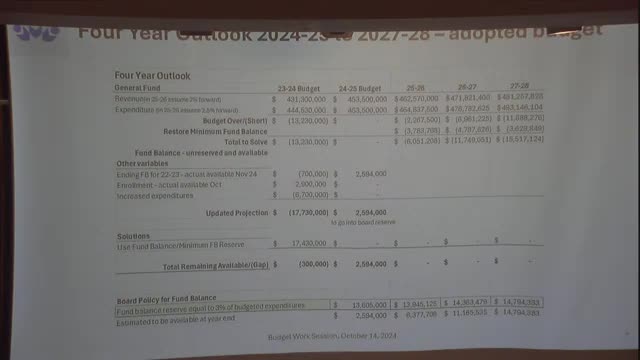Budget Crisis Deepens as Revenue Falls Behind Costs
October 14, 2024 | Northshore School District, School Districts, Washington
This article was created by AI summarizing key points discussed. AI makes mistakes, so for full details and context, please refer to the video of the full meeting. Please report any errors so we can fix them. Report an error »

During a recent government meeting, officials discussed the ongoing financial challenges faced by the district, particularly the persistent gap between revenue growth and expenditure. The conversation highlighted a significant concern: expenditures are projected to grow at a rate of 3%, while revenue growth is estimated at only 2%, a decrease from previous projections.
The discussion revealed that the 2% revenue growth estimate is closely tied to inflationary factors that the state is expected to fund. Officials noted that the actual costs incurred by the district often exceed the funding received, particularly regarding the Inflationary Price Deflator (IPD) used to calculate salary increases. This disconnect results in the district needing to cover additional costs that are not fully funded by the state, leading to a shortfall of approximately $1 million.
Officials emphasized that while they have tightened expenditure projections and implemented better budget controls, the fundamental issue remains: the state's funding does not adequately reflect the actual inflationary pressures faced by the district. This discrepancy has led to ongoing cost-cutting measures and a need for continued vigilance in financial planning.
The board anticipates a more comprehensive update on these financial projections in November, which will provide further clarity on the district's fiscal outlook. The meeting underscored the broader implications of funding disparities and the challenges of maintaining educational quality amid financial constraints.
The discussion revealed that the 2% revenue growth estimate is closely tied to inflationary factors that the state is expected to fund. Officials noted that the actual costs incurred by the district often exceed the funding received, particularly regarding the Inflationary Price Deflator (IPD) used to calculate salary increases. This disconnect results in the district needing to cover additional costs that are not fully funded by the state, leading to a shortfall of approximately $1 million.
Officials emphasized that while they have tightened expenditure projections and implemented better budget controls, the fundamental issue remains: the state's funding does not adequately reflect the actual inflationary pressures faced by the district. This discrepancy has led to ongoing cost-cutting measures and a need for continued vigilance in financial planning.
The board anticipates a more comprehensive update on these financial projections in November, which will provide further clarity on the district's fiscal outlook. The meeting underscored the broader implications of funding disparities and the challenges of maintaining educational quality amid financial constraints.
View full meeting
This article is based on a recent meeting—watch the full video and explore the complete transcript for deeper insights into the discussion.
View full meeting
